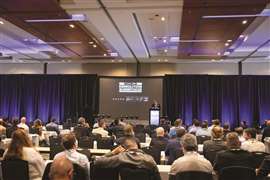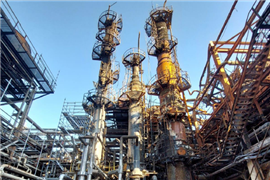Cream of the crop - the 2013 Contract of the Year winner
03 December 2013

The words of one of the judges that assessed the entries in the Contract of the Year category in the 2013 World Demolition Awards best sum up the winning entry from Hunter Demolition. He said: “Hunter’s Glasgow city centre project is a superb example of performing high profile demolition work with meticulous attention to every environmental concern and technical challenge within the very heart of a major urban arena.”
110 Queen Street, in the heart of Glasgow City Centre, was originally built in 1971.The building was a former Bank of Scotland Bank branch and main office and had been unoccupied for a number of years. This 7 storey building was made up of concrete frame with bison floor slabs on the outside of which sat concrete panels 8 m (26.2 ft) long x 2 m (6.6 ft) wide that were fixed to the concrete frame of the building on each level. There were two lift shafts and in the basement sat the old bank vaults. Hunter Demolition was sub contracted to demolish this site by client BAM Construction.
The building was surrounded by offices, high end retail outlets, city centre residential living and tourists, and was on a main bus route into the heart of the city, with over 100 buses an hour passing the site. Careful and meticulous planning to take account of the environmental impact the project would have on the surrounding area and those within the area was essential. As always, Health and Safety was a major issue that was again meticulously planned for. Hunter had to ensure the safety of all of its staff, the public and surrounding businesses and buildings. Space around the site was at a premium given its proximity to the buildings and main route surrounding it.
Bringing it down
Hunter Demolition were contracted to safely demolish the existing building and remove the basement and pile caps to allow for a new building to be constructed by the client. Due to the lack of original construction drawings Hunter approached BAM Construction to arrange a ‘Soft Start’ to the project that allowed investigation works on the building to be carried out prior to the official programme start date to determine how the concrete panels had been fixed and how the building was attached to the adjacent buildings - Lomond House on Hanover Street and Olympic House on Queen Street. This also allowed Hunter to develop safe methods of work for the demolition of the building.
Firstly the concrete panels were removed using cranes, with lifting pins having to be specially made to incorporate the weight of the panels, and the angle and location of the existing lifting holes. This was a new initiative that relied on design and reverse engineering in order to remove the panels in a way that increased the safety of the operatives involved. They were removed to plan without any incident. The removal of these panels was a whole new concept.
With the concrete panels removed, Hunter carried out the safe demolition of the building using a 40 m (132 ft) high reach machine along with support from a Cat 345 with an extended boom to remove the main parts of the building but leaving the end sections that tie into the adjoining buildings. Once down to ground level the material from the demolition was then processed on site and set aside for crushing to 6f2 grade at a later date. In total, Hunter removed 2,822.5 tonnes of 6f2, 1.9 tonnes of timber, 5,338.8 tonnes of concrete and 929.3 tonnes of miscellaneous scrap, all of which will be processed for recycling.
The two ends that tied into the neighbouring properties were then demolished using a mixture of mechanical demolition and hand demolition since during original investigation works a 250 mm (10 inch) cavity was found between the buildings.
Due to the location and the close proximity of pedestrians and vehicles, Hunter carried out some of the demolition works during the evenings and on Sundays. This part of the work involved localised footpath and road closures and was carried out working very closely with the local council’s roads department, local bus companies, surrounding businesses and residents to allow the corner sections that were located close to the normally “live” footpaths and roads to be taken down.
Asbestos removal and internal soft stripping works had been undertaken by others prior to the demolition work commencing. However, once work was underway and Hunter was three weeks into the programme, asbestos was discovered. Work within this area ceased immediately until testing was carried out. While testing was carried out, and rather than work stop completely, the methodology was changed in agreement with the client and the team moved to another area to commence demolition, therefore allowing the contractor to stay within programme.
With the above ground demolition complete Hunter started to remove the material from within the basement and break out the basement walls and the walls to the vaults. Crushing of demolition rubble started and while this was ongoing removing the pile caps commenced. With all the basement removal works complete Hunter Demolition backfilled and compacted 6f2 material in 300 mm (12 inch) layers up to the existing ground level ready for piling works to commence by the client.
Customer Care:
Customer care was a large factor in this project. Complaints of varying natures arrived daily. The Chair of the Local Community Group, who was acting as spokesperson for the Community, delivered a few complaints that were handled immediately. He also delivered a number of compliments regarding “The site management being spot on” and the appearance on the site. The site was also visited by Glasgow City Councils Environmental Health on a few occasions who were following up on complaints received direct to them.
In order to ensure that there was no danger or impact to surrounding buildings due to the work involved in the demolition, movement and vibration monitoring was ongoing in a number of buildings around the site. This helped to alleviate concerns from various businesses and residents who were concerned about possible impact on the stability of their building. The monitoring levels were always below the British standard and as a goodwill gesture to these businesses and residents, Hunter introduced a quiet hour each day to allow them to conduct sensitive business and this has proved to be a success.
The site was also under the Considerate Contractors Scheme and was visited by an auditor to conduct an assessment. The site scored 42 out of 50 (the first for a BAM site) and special recognition was given to the dust suppression system that was in force.
Gordon Topham, Consider Contractors Scheme Auditor said that “the introduction of a Snow Making machine adapted to project an atomised water mist over the full demolition area trapped any dust created by the works and brought it effectively to the ground. The air quality on site and in adjacent streets is independently monitored and compared to the pre-start results. These checks demonstrated that the air quality has not decreased and that the local passers-by and buildings are not being detrimentally affected by the unavoidable dust created by work of this nature. If this system was adopted on all demolition sites a considerable improvement would be seen across the industry in the air quality on demolition sites.”
Hunter removed the original street signs and a commemorative brass plaque that commemorated a previous school and Gaelic Church that had been on the site from 1818 until 1839, when it was demolished to make way for the British Linen Bank. These artefacts are likely to be donated to a local museum.
CONNECT WITH THE TEAM








